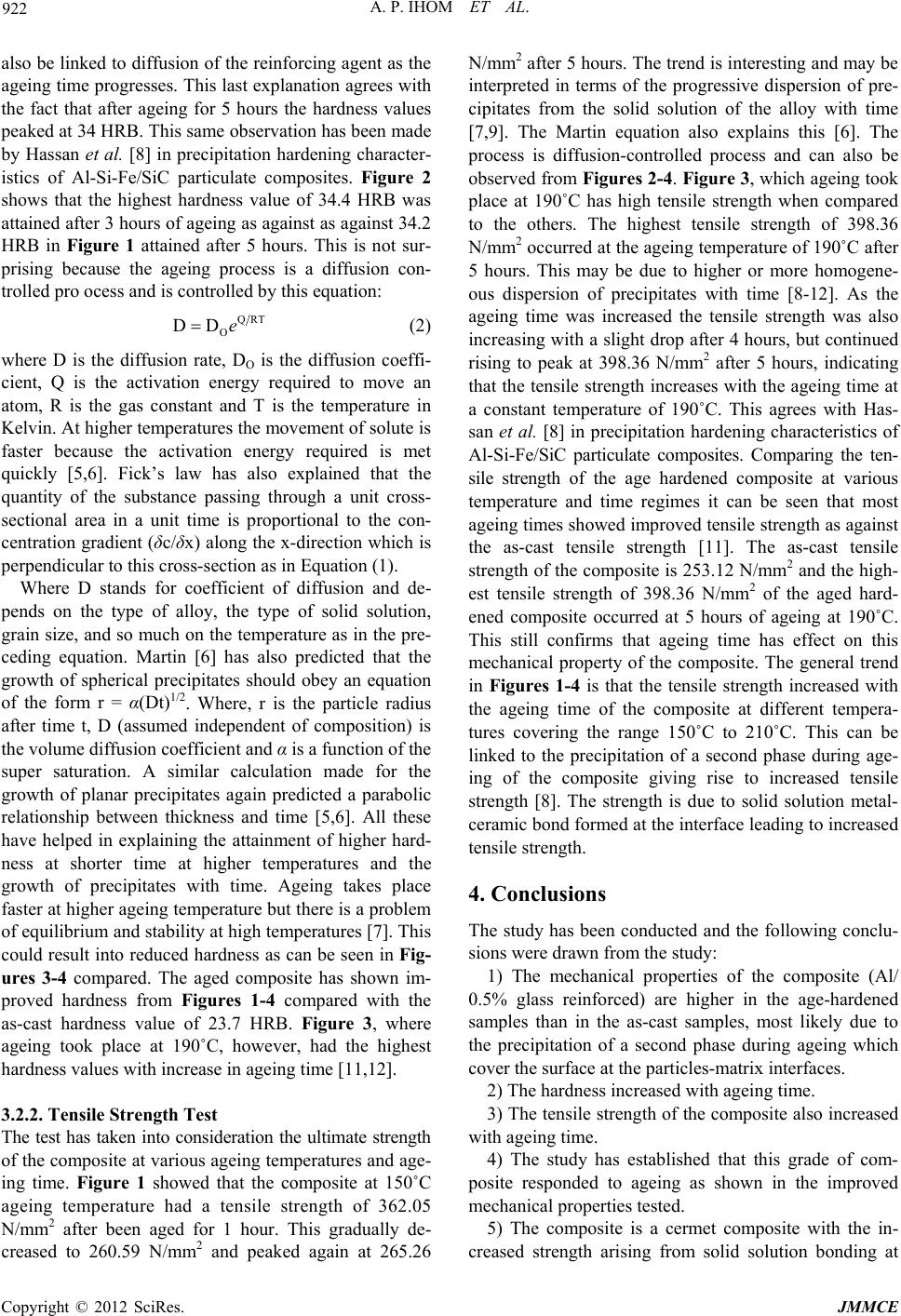
A. P. IHOM ET AL.
922
also be linked to diffusion of the reinfo rcing agent as the
ageing time progresses. This last explanation agrees with
the fact that after ageing for 5 hours the hardness values
peaked at 34 HRB. This same observation has been made
by Hassan et al. [8] in precipitation hardening character-
istics of Al-Si-Fe/SiC particulate composites. Figure 2
shows that the highest hardness value of 34.4 HRB was
attained after 3 hours of ag eing as against as against 34.2
HRB in Figure 1 attained after 5 hours. This is not sur-
prising because the ageing process is a diffusion con-
trolled pro ocess and is controll ed by thi s e q uat i on:
QRT
O
DDе (2)
where D is the diffusion rate, DO is the diffusion coeffi-
cient, Q is the activation energy required to move an
atom, R is the gas constant and T is the temperature in
Kelvin. At higher temperatures the movement of solute is
faster because the activation energy required is met
quickly [5,6]. Fick’s law has also explained that the
quantity of the substance passing through a unit cross-
sectional area in a unit time is proportional to the con-
centration gradient (δc/δx) along the x-direction which is
perpendicular to this cross-section as in Equation (1).
Where D stands for coefficient of diffusion and de-
pends on the type of alloy, the type of solid solution,
grain size, and so much on the temperature as in the pre-
ceding equation. Martin [6] has also predicted that the
growth of spherical precipitates should obey an equation
of the form r = α(Dt)1/2. Where, r is the particle radius
after time t, D (assumed independent of composition) is
the volume diffusion coefficient and α is a function of the
super saturation. A similar calculation made for the
growth of planar precipitates again predicted a parabolic
relationship between thickness and time [5,6]. All these
have helped in explaining the attainment of higher hard-
ness at shorter time at higher temperatures and the
growth of precipitates with time. Ageing takes place
faster at higher ageing temperature but there is a problem
of equilibrium and stability at h igh temperatures [7]. This
could result into reduced hardness as can be seen in Fig-
ures 3-4 compared. The aged composite has shown im-
proved hardness from Figures 1-4 compared with the
as-cast hardness value of 23.7 HRB. Figure 3, where
ageing took place at 190˚C, however, had the highest
hardness values with increase in ageing time [11,12].
3.2.2. Tensile Strength Test
The test has taken into consideration the ultimate strength
of the composite at various ageing temperatures and age-
ing time. Figure 1 showed that the composite at 150˚C
ageing temperature had a tensile strength of 362.05
N/mm2 after been aged for 1 hour. This gradually de-
creased to 260.59 N/mm2 and peaked again at 265.26
N/mm2 after 5 hours. The trend is in teresting and may be
interpreted in terms of the progressive dispersion of pre-
cipitates from the solid solution of the alloy with time
[7,9]. The Martin equation also explains this [6]. The
process is diffusion-controlled process and can also be
observed from Figures 2-4. Figure 3, which ageing took
place at 190˚C has high tensile strength when compared
to the others. The highest tensile strength of 398.36
N/mm2 occurred at the ageing temperature of 190˚C after
5 hours. This may be due to higher or more homogene-
ous dispersion of precipitates with time [8-12]. As the
ageing time was increased the tensile strength was also
increasing with a slight drop after 4 hours, but continued
rising to peak at 398.36 N/mm2 after 5 hours, indicating
that the tensile strength increases with the ageing time at
a constant temperature of 190˚C. This agrees with Has-
san et al. [8] in precipitation hardening characteristics of
Al-Si-Fe/SiC particulate composites. Comparing the ten-
sile strength of the age hardened composite at various
temperature and time regimes it can be seen that most
ageing times showed improved tensile streng th as against
the as-cast tensile strength [11]. The as-cast tensile
strength of the composite is 2 53.12 N/mm2 and the high-
est tensile strength of 398.36 N/mm2 of the aged hard-
ened composite occurred at 5 hours of ageing at 190˚C.
This still confirms that ageing time has effect on this
mechanical property of the composite. The general trend
in Figures 1-4 is that the tensile strength increased with
the ageing time of the composite at different tempera-
tures covering the range 150˚C to 210˚C. This can be
linked to the precipitation of a second phase during age-
ing of the composite giving rise to increased tensile
strength [8]. The strength is due to solid solution metal-
ceramic bond formed at the interface leading to increased
tensile strength.
4. Conclusions
The study has been conducted and the following conclu-
sions were drawn from the study:
1) The mechanical properties of the composite (Al/
0.5% glass reinforced) are higher in the age-hardened
samples than in the as-cast samples, most likely due to
the precipitation of a second phase during ageing which
cover the surface at the particles-matrix interfaces.
2) The hardness increased with ageing time.
3) The tensile strength of the composite also increased
with ageing time.
4) The study has established that this grade of com-
posite responded to ageing as shown in the improved
mechanical properties tested.
5) The composite is a cermet composite with the in-
creased strength arising from solid solution bonding at
Copyright © 2012 SciRes. JMMCE